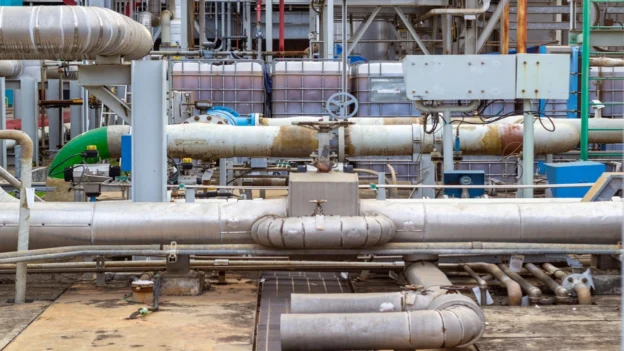The oil and gas industry relies on thermal insulation to maintain process efficiency, reduce energy loss, and enhance workplace safety. However, insulation also presents a significant challenge: Corrosion Under Insulation (CUI). CUI is one of the most persistent and costly integrity threats, developing undetected beneath insulation and leading to structural degradation, leaks, and potential failures.
CUI is particularly common in piping systems exposed to cyclic temperatures, especially those operating between -4°C and 175°C, where condensation is likely to occur. If left undetected, CUI can result in costly repairs, unplanned shutdowns, and serious safety hazards. Traditional inspection methods, such as visual examination or random insulation removal, are often ineffective, labor-intensive, and costly.
Addressing these risks requires proactive measures, effective inspection strategies, and advanced monitoring technologies to ensure early detection and mitigation. As insulation degrades over time, the likelihood of CUI increases, making periodic inspection essential for maintaining asset integrity.
To overcome these challenges, the industry is increasingly adopting smart monitoring solutions that integrate advanced Non-Destructive Testing (NDT) technologies, embedded sensors, and data analytics. These innovative approaches enhance early detection, reduce maintenance costs, and ensure the long-term safety and reliability of critical infrastructure.
Latest NDT innovations for continuous CUI monitoring
Real-time monitoring technologies are revolutionizing how industries manage corrosion under insulation. Wireless corrosion sensors, installed under insulation in high-risk areas such as offshore platforms, plant piping’s and LNG terminals, provide continuous monitoring of moisture levels—the primary cause of CUI. These sensors detect water ingress in real time, enabling early intervention and reducing reliance on costly, labor-intensive periodic inspections. By integrating cloud-based data transmission, operators can remotely access corrosion data, analyze trends, and implement predictive maintenance strategies.
To ensure accuracy, sensor data must be validated using advanced NDT techniques such as Guided Wave Ultrasonics, Pulsed Eddy Current, Digital Radiography. These non-intrusive methods assess corrosion severity without removing insulation, enabling targeted inspections. This combination of smart monitoring and advanced NDT minimizes false positives, optimizes inspection efforts, and enhances asset reliability.
Smart NDT technologies work alongside intelligent sensors to verify all reported indications, ensuring a more accurate assessment of CUI risks. By integrating real-time monitoring with advanced inspection techniques, industries can strengthen plant integrity, prevent unexpected failures, and maintain safe, reliable operations. A proactive approach utilizing both technologies helps industries mitigate CUIrelated damage while optimizing maintenance resources.
By shifting from reactive to predictive maintenance, industries can significantly lower inspection costs while improving safety and infrastructure integrity. Continuous CUI monitoring minimizes unplanned downtime and extends asset life, ensuring compliance with industry regulations. As digitalization advances, integrating real-time monitoring with NDT validation will be key to achieving long-term operational efficiency and reliability.
Smart advanced NDT techniques for CUI detection and verification
1. Pulsed eddy current (PEC)
PEC is an advanced electromagnetic inspection technique designed to detect corrosion and wall loss in insulated and coated components without requiring direct surface contact. It is particularly useful for detecting CUI in piping, pipelines, storage tanks, and process vessels, where traditional methods would require costly insulation removal. As a smart NDT solution, PEC serves as a valuable verification tool, validating hidden CUI risks identified by intelligent sensors while providing fast and reliable screening across large surface areas.
2. Guided wave ultrasonics (GWUT)
GWUT is a long-range inspection technique that uses low-frequency ultrasonic waves to detect anomalies such as internal and external corrosion in pipes and structural components. These waves travel along the length of the pipe, allowing for rapid screening of extended sections, even when covered by insulation, coatings, or buried underground. GWUT’s ability to detect CUI without direct access makes it a powerful complement to intelligent sensors, verifying hidden corrosion risks in challenging environments. Its capability to assess pipe integrity over long distances minimizes the need for intrusive inspections, improving efficiency and reducing downtime.
3. Robotic inspection using digital radiography (DR)
Robotic inspection utilizing Digital Radiography (DR) combines automation with high-resolution X-ray imaging to detect internal corrosion, external pitting, and material loss in both insulated and uninsulated assets. DR technology captures digital images of internal structures without requiring insulation removal, making it highly effective for assessing CUI. The integration of robotics allows for remote inspection of hard-to-reach areas, reducing safety risks and human intervention. By providing detailed, real-time imaging, DR-based robotic inspection enhances the verification process of hidden CUI risks reported by intelligent sensors, ensuring accurate and data-driven maintenance decisions.
Conclusion
CUI remains one of the most challenging integrity threats in the oil and gas industry due to its hidden nature and potentially severe consequences. Traditional inspection methods are often insufficient, making smart NDT solutions essential for effective detection and management. By integrating real-time monitoring, advanced NDT techniques, and predictive maintenance strategies, industries can significantly enhance their ability to detect and mitigate CUI risks. This proactive approach ensures long-term asset integrity, minimizes operational disruptions, and strengthens the safety and reliability of critical infrastructure.
This article was written by specialist Mohammed A. Abufour and published as part of the fifth edition of Inspenet Brief magazine August 2025, dedicated to technical content from the energy and industrial sectors.

